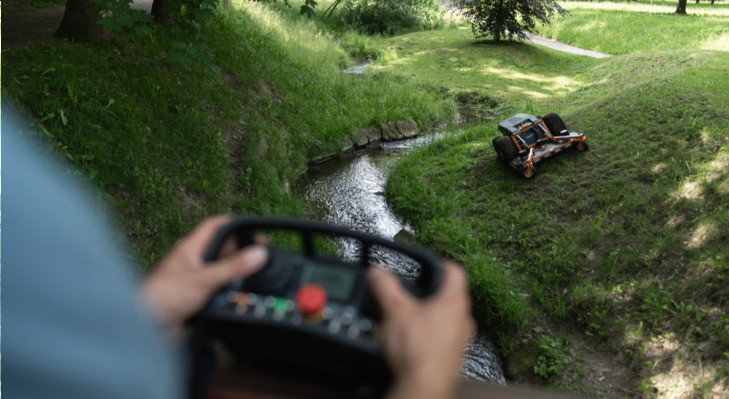
This is perhaps the most frequent question we get asked whenever we present or demonstrate the machine. And, since Raymo is controlled by the means of a radio handset, it is a legitimate one too. But this applies generally to all RC machines

This is perhaps the most frequent question we get asked whenever we present or demonstrate the machine. And, since Raymo is controlled by the means of a radio handset, it is a legitimate one too. But this applies generally to all RC machines
Let’s take a look at some of the factors that directly influence the radio signal distance. Raymo, just like most of the other machinery remote controls used nowadays, works in the 400 to 900 MHz range (based on the country legislations) as this frequency gives a good proportion between distance and the amount of information that can be transmitted. In general, the lower the frequency is, the longer the wavelength and the greater the distance. Long waves have the ability to avoid larger obstacles and thus travel a longer distance. The downside is that they can carry only a limited amount of information. On the contrary the higher the frequency, the more information can be included in the transmission, but – as the wavelength is short – the broadcasting range is limited. You could rightly argue that you can compensate the distance by increasing the transmitting power. This is generally true, but not in case of these radio control handsets, where the transmitting power output is limited to 10mW – mainly for health and safety reasons and limitation of interference.
So, with these particular frequencies and power outputs the maximum radio control distance under ideal conditions can be up to 300 meters (1000 feet). This, however, is hardly ever true and the radio range will most likely be around 100 meters (300 feet) as there are many other factors that we need to take into consideration. Which ones are these? Interference is perhaps the most important one. If there is equipment operating on a similar frequency, the interfering signal may significantly reduce the radio signal reach. Luckily the radio controller can work on multiple channels so – on in case you experience signal drop outs – you can switch to another frequency. Radio signal can also deteriorate in the presence of a strong electromagnetic filed. This can happen if you operate under high voltage power lines or – for example - if your antenna is close to the engine spark plugs. Yes, these also create a strong electromagnetic field.
Other factors that can influence the quality of the radio connection are nearby buildings (they reflect the signal), obstacles to direct visibility, antenna placement on the machine and also weather. However, be sure that in case the radio signal is corrupted or lost, the machine always safely stops and presents no danger to the operator or other people or property.
The crucial thing to remember is that the purpose of the radio control is not the maximum distance, but to keep the operator safe and away from dangerous working conditions. 90% of the time you will be working within the range of 5 to 30 meters (15 to 100 feet) because the limitation will not be the radio signal, but your eyesight. At 30+ meters (100+ feet) it is already difficult to judge the distance between the mower and the obstacles. With increasing distance, the precision and productivity of your work will be quickly reduced.
To summarize – always stay within a safe distance (not too near, not too far) at which you can precisely control the machine and yet stay away from any risk. And be sure that most of the time the maximum radio distance will be longer than that the distance at which you can still fully trust your eyesight.